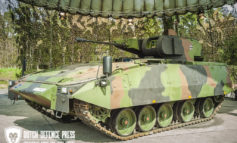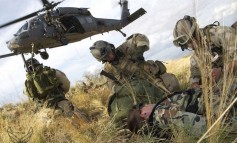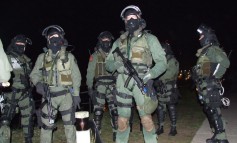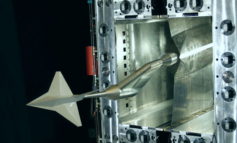‘Homeland defence’ a slogan now both common and predictive – since the 9-11 attacks two years ago in the U.S. – captures the new realities of fighting an unseen enemy on multiple fronts in an even so dynamic world. An awakening that came at a horrible price and still terrorists aspire to even greater destruction. While signs of a revived Al Qaeda are seen, according to senior counterterrorism officials in the U.S., Europe and the Middle East. Leaders and operatives of Al Qaeda have reorganized bases of operations in at least a half-dozen locations, including Kenya, Sudan, Pakistan and Chechnya. They have begun to recruit new members, train the new followers and plan new attacks on Western targets in earnest. A number of elements of the U.S and its allied armed forces will engage in small-units counterterrorist actions abroad, while homeland first responders see to the domestic scene. These teams, including the fire, police, emergency medical and domestic based armed forces units must be on the spot quickly, make critical decisions and take action. As well, other governmental groups and humanitarian relief organizations battle terrorism on different, but no less important, levels. Complicating factor is that very little defensive training to fight a war against terrorists has been initiated. But times are changing fast. Since ‘homeland defenders’ are looking across a broad collection of technologies to discover ways to stop terrorists, most likely that PC-based games may provide at least part of the answer in this quest.
Computer-generated warriors fighting virtual wars in a cyber world will soon help to train live soldiers. Mind dazzling advances in computer simulation software and graphics technology are bringing computer generated warriors, virtual cities, and battlefields in deserts, mountains and jungles to life. By reproducing the real world, they are helping ‘defenders’ read the terrorist mind and kill the dark thoughts residing there. PC-based software will soon evolve to specific uses in the indistinct war against terrorists. Combined with other types of training, including complex simulation suites, advanced PCs and sophisticated software, the once giddy PC-gaming culture is moving to the front lines of defence. And the front lines are everywhere: bridges, buildings, dams, nuclear plants, public sporting events and shopping malls. Fighting terrorism is fighting the unknown, with adversaries capable of doing things that have never been imagined. Though, positive work is being done to develop counterterrorist scenarios, shape them into software programs and use them as training tools. Custom-built, modifiable PC war-gaming is surfacing that relies on large overlays of realism supplied by graphics software. Some U.S. Special Operations units are currently doing some things with the help of ‘Spectrum’. The capabilities of this computer simulation, developed at the U.S. National Simulation Centre, are initially being introduced into the U.S. Army’s One Semi-Automated Force program. Which is a high-resolution, entity-level model managed by the U.S. Army’s Simulation, Training and Instrumentation Command for training at the battalion level and above. It is a PC-based simulation for C2 training in low-intensity operations. It was originally designed to satisfy the need for training the commander and battle staff in military operations other than war. These actions would typically be carried out in hostile surroundings that might be chaotic or uncontrolled, typical of a terrorist environment. A key ‘Spectrum’ feature in this simulation is a capability that can help train non-military organizations as well. Other introduced software products are ‘Combat System 12’, a PC-based game developed by Quicksilver Software Inc., and ‘C-Force’, a next-generation console game from Future Combat Systems LLC. Both are built for the Institute for Creative Technologies (ICT), which is an U.S. Army-funded research facility for producing advanced military simulations and part of the University of Southern California. Combat System 12 offers an immersive 3-D simulation of modern light infantry operations in urban and semi-urban environments. A company commander, who’s in charge of approx. 120 soldiers, faces various asymmetrical threats. Medical or humanitarian personnel may also be involved. To further complicate matters, the use of deadly force may not necessarily be the best course of action. C-Force will centre on the role of a squad leader in such operations. It present real-time tactical challenges based on military operations in urban terrain. Both these games are cutting-edge, forward-looking, critical decision-making training tools. They’ve been built for both company and small-unit operations. Nevertheless, they look more broadly at what combat systems and force considerations might be in some ten or fifteen years from now. These software products will help soldiers rehearse their missions in a gaming environment, and can be used for several aspects of counterterrorism operations. But they were not designed specifically for that purpose. The products have built-in mission editor features, which allow new training scenarios, weapons and environments – from deserts to jungles – to be developed as real-world events dictate.
Additional fascinating advanced simulation work is being done at the U.S. Institute for Defence Analyses (IDA) Simulation Centre. Which is a Defence Department-funded, nongovernmental organization that promotes national security and the public interest. A group of researchers, called the ‘terrain team’, produce highly accurate, PC-based 3-D simulations of cities where battles against terrorists might be fought. The counterterrorist aspects of IDA’s work are embedded in a simulation program called ‘Virtual Emergency Response Training System’ that aims at managing the consequences of terrorist attacks involving weapons of mass destruction. It entails building virtual cities for integration into the interactive simulation. These realistic, highly detailed urban databases are essential for training the military, civil support teams and other first responders. A counterterrorist scenario could be built using IDA city models. The virtual city simulations can be augmented with manned simulations and with software that inserts semi automated, computer-generated, small-unit forces in and among buildings. Within these combined simulations, scenarios can be developed to help first response units to face terrorist incidents at subways, highways, rail stations, chemical storage facilities, airport terminals and railway crossings. These situations might involve hostages, derailments or operations involving hazardous materials. Some agencies have been training with ‘Rogue Spear’, a PC-based consumer simulation developed primarily for manoeuvring through buildings. IDA also worked with the U.S. Defence Modelling and Simulation Office and the U.S. Marine Corps on an application optimized for the outside and inside of buildings. It will allow them to create their own virtual cities, vehicles and equipment. IDA is also working with the U.S. Special Operations Command to identify counterterrorism applications. Affordable PC-based software games will eventually be as available to civil responders as they are to military purchasers today, with IDA acting as a major enabler in such access.
The merging of military and commercial worlds has also brought into focus some pitfalls in using a fantasy-based consumer war-gaming product to train survivability and mission success in real ‘life-and-death’ confrontations. The way software modifications are made is extremely important. A key obstacle is the unpredictable nature of the enemy. Terrorist’s methods are unconventional and self-destructive. Their battlegrounds are nearly everywhere, their foes nearly everyone. In the new world of counterterrorism, conducting military operations other than war means modifying traditional command and control (C2) methods. It also means looking at the ways the military trains counterterrorist fighters. There are a lot of difficulties involved in preparing PC tools and counterterrorist simulations. Specially training a large number of agencies at various levels in counterterrorism is a major issue. For example, by simply adding correct weapons and terrorist images to commercial software games will not make them work effectively as training tools. Most of the commercial ‘first-person shooter’ war games used today were never written to observe the rules of engagement. There’s very little if any proper military doctrine contained in consumer war games. Despite these difficulties, executives within the software and simulation worlds believe PC-based antiterrorism training is crucial for preparing soldiers and civilian responders. Simulations are attractive to the trainees because they allow them to train at any time and at any site. Additionally, simulations increase proficiency and augment the more physical aspects of military training. Most importantly, they help soldiers and civilian first responders overcome cultural barriers, letting security specialists conceive the previously inconceivable in terms of how terrorist minds work. Within an environment of increasing awareness and change, there is little doubt that PC training will assume a larger role. That role will become more apparent as the defence establishment applies the best in computer game technology to counter the worst enemies it can throw at it.












Leave a Reply